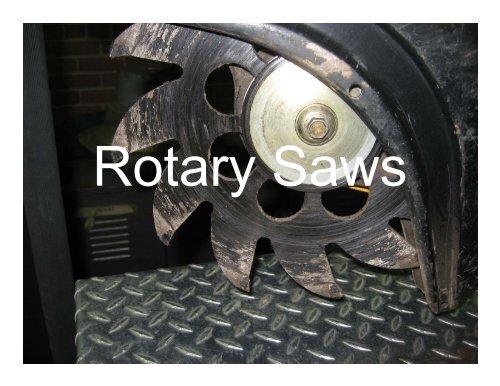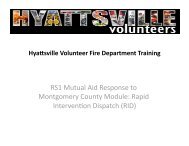Rotary Saws
Partner K-950 Fire/Rescue Saw
Partner K-950 Fire/Rescue Saw
- No tags were found...
You also want an ePaper? Increase the reach of your titles
YUMPU automatically turns print PDFs into web optimized ePapers that Google loves.
<strong>Rotary</strong> <strong>Saws</strong>
Partner K-950 Fire/Rescue Saw<br />
• Displacement: 94cc<br />
Power: 6.1 hp<br />
Weight: 22.9 lbs<br />
Fuel Capacity: 23.7 oz<br />
Engine Speed: 5,400 rpm (max<br />
spindle speed)<br />
Arbor Size: 1 inch (25.4mm)
Partner K 700 Active III<br />
• Displacement: 71cc<br />
Power: 4.8 hp<br />
Weight: 20.5 lbs<br />
Fuel Capacity: 23.7 oz<br />
Engine Speed: 5,400 rpm (max spindle<br />
speed)<br />
Arbor Size: 1 inch (25.4mm)
Partner K1200 Mark II<br />
• Displacement: 100cc<br />
Power: 4.8 hp<br />
Weight: 30 lbs<br />
Fuel Capacity: 23.7 oz<br />
Engine Speed: 5,100 rpm (max spindle<br />
speed)<br />
Arbor Size: 7/8 inch
SAFETY OPERATIONS<br />
The following safety equipment should be<br />
used at all times:<br />
1. Gloves<br />
2. Goggles<br />
3. Helmet<br />
A safety firefighter shall be utilized in<br />
all cases.
SAFETY OPERATIONS<br />
Two hazards unique to the rotary saw make it an extremely<br />
dangerous tool.<br />
• First, the blade continues to spin at high rpms long after<br />
the throttle is released, or after the saw is shut off.<br />
Leaving the saw unattended in this condition should not be<br />
done under any circumstances. The blade should be stopped<br />
in the work or monitored until it stops spinning.<br />
Turning with a running saw in hand must be done with<br />
extreme caution.<br />
• The second hazard is the gyroscopic effect caused by the<br />
spinning blade. This makes the saw somewhat unwieldy when<br />
changing its cutting angle (this is inherent to the saw<br />
and the operator should be aware of this).
SAFETY OPERATIONS<br />
• Particular care should be paid to the surrounding area.<br />
When cutting metal, the saw throws off hot sparks which<br />
can provide an ignition source in flammable<br />
atmospheres or to combustible solids.<br />
• Care should be taken to have firefighters and<br />
extinguishing equipmen (hand line and/or dry chemical<br />
extinguisher) in place prior to the cutting operation if the<br />
situation calls for these precautions<br />
• Care must be taken that the area in the path of the<br />
sparks is clear prior to cutting with the saw. Hot sparks<br />
can be thrown up to 15 feet from the cutting area.
USE OF BLADES<br />
Blades are available in three basic types;<br />
carbide tipped blades (wood), abrasive<br />
wheels (masonry/metal), and diamond<br />
blades (concrete).<br />
Anatomy of a saw blade
USE OF BLADES<br />
Their uses include:<br />
• carbide tipped, used for cutting<br />
composition roofing material, wood, and<br />
lexan. They can also be used on light<br />
sheet metals such as door cladding or<br />
aluminum sheet with care.
• The Warthog is a carbide tip saw blade designed especially for fire<br />
department venting operations. Be it floors, walls or roofs, the<br />
Warthog's aggressive tooth design cuts through roofing materials,<br />
wood flooring and siding like a hot knife through butter.<br />
Nothing Cuts Like A Warthog<br />
The aggressive tooth design of the Warthog blade easily and quickly<br />
cuts through roofing materials, wood flooring and siding. Heavy duty<br />
construction helps prevent tip loss, the major problem with standard<br />
carbide tip saw blades. Each oversized carbide tip is mounted to the<br />
blade by a special process. This cushions the tip mounting and<br />
makes this blade the most durable (and probably the last) ventilation<br />
saw blade you will ever buy.
Composition blades<br />
• There are two (2) types of composition<br />
blades; the masonry cutting blade and the<br />
metal cutting blade.<br />
• Grit and resin epoxy agents are specially<br />
formulated to cut specific materials.<br />
• Abrasive blades are fiber reinforced for<br />
added strength and longer wear.
Masonry Cutting Blade<br />
• A composition blade life can be extended<br />
by applying water on the work surface as<br />
this cools the blade and reduces dust in<br />
the atmosphere.<br />
• The blade can also be used as a backup<br />
blade to cut light metals
Metal Cutting Blade<br />
• A composition blade used to cut metals<br />
that may be encountered during rescue or<br />
forcible entry situations.
Diamond Blade<br />
• An expensive, fast cutting blade with a blend<br />
of hardened, synthetic diamond material<br />
fastened to the outer edge.<br />
• Arrows are located near the hub indicating<br />
direction of blade rotation (see Figure 3).<br />
• This blade can cut masonry, reinforced concrete,<br />
and mixed materials.<br />
• Avoid cutting metal as this will reduce blade life.
OPERATING TIPS<br />
To prevent the blade from binding during cutting<br />
operations, use the following procedures:<br />
1. Adjust blade guard to control cutting depth.<br />
2. Enter all cuts at full rpm.<br />
3. While cutting vertical surfaces, make certain blade<br />
is kept at right angle to surface.<br />
4. Always cut in straight line (do not twist saw to,<br />
either side).<br />
5. Release throttle and immediately remove blade from<br />
cutting surface if binding occurs to avoid belt<br />
damage.
OPERATING TIPS<br />
• The rotary saw is excellent when<br />
used for cutting thick or heavy roof<br />
composition as found on flat or<br />
older types of roof construction.<br />
• The operator may experience<br />
problems if attempting to use the<br />
rotary saw for ventilation purposes<br />
on steep pitched roofs.<br />
• Judgment should be used prior to<br />
operating the saw on any roof that<br />
is more than slightly pitched. This<br />
is mainly due to reduced reach and<br />
gyroscopic effect. In addition,<br />
the ability to feel structural<br />
members is difficult.
OPERATING TIPS<br />
• If used for ventilating light weight roofs,<br />
particular care should be taken to assure the<br />
proper depth of cut.<br />
• During emergency operations, the combination<br />
wrench should be carried to facilitate adjustment<br />
of the belt or provide blade change.<br />
• A saw can be rendered unserviceable very<br />
quickly if the belt is improperly adjusted.<br />
• A saw bag can be used to bring each blade type<br />
to the cutting site, providing greater flexibility to<br />
the operator.
MAINTENANCE INSTRUCTION<br />
Daily Checks<br />
1. Check fuel for level.<br />
2. Check the blade for<br />
sharpness and proper<br />
mounting.<br />
3. Check the blade guard for<br />
damage.<br />
4. Check the belt for tension.<br />
5. Make a visual check of the<br />
saw for loose nuts and<br />
bolts.<br />
6. Check the controls for proper<br />
starting position.<br />
7. Check the carrying strap and<br />
hooks for condition.
MAINTENANCE INSTRUCTION<br />
Weekly Checks<br />
1. Start the saw and<br />
operate until warm.<br />
2. Run up rpm to verify<br />
that the blade runs<br />
true and smooth<br />
without wobble or<br />
vibration.<br />
3. Listen for abnormal<br />
sounds.
MAINTENANCE INSTRUCTION<br />
Monthly Checks<br />
1. Maintain a clearance of .020" at the spark plug gap<br />
on all Partnersaws. Clean plug as necessary or replace.<br />
2. Remove the cutting blade and check the bearings on the<br />
arbor. The arbor should rotate freely, without<br />
roughness. If roughness is felt, the saw should be<br />
sent for repair.<br />
3. Inspect the engine case for cracks or leaks.<br />
4. Inspect the fuel assembly for leaks, cracked or soft fuel<br />
lines. DO NOT operate saw if there is a fuel leak.
MAINTENANCE INSTRUCTION<br />
Monthly Checks<br />
5. Before replacing blade, check the condition of the<br />
blotters. Abrasive blades with damaged blotters<br />
should not be used.<br />
6. Check the belt for condition and tension. If the belt<br />
is worn or frayed, replace.<br />
7. If a tank of fuel has not been used in the<br />
previous 30 days, drain fuel and refill with<br />
fresh fuel.
After Use<br />
1. Refuel saw as necessary.<br />
2. Examine cutting blades after each use. Blade should<br />
meet the criteria in the following section titled<br />
"Mounting or Changing Blades."<br />
If a carbide tipped wood cutting blade was used, check<br />
for tip damage and sharpness.<br />
3. Check the air filter for accumulation of debris and<br />
fiber condition. To remove trapped debris, tap the<br />
filter gently on the palm of your hand. Compressed air<br />
or solvents should not be used to clean paper filters.
After Use<br />
4. Check for loose or bare wires, loose nuts and screws,<br />
and cracked or broken parts. Tighten or repair as<br />
necessary.<br />
5. The rotary saw shall be thoroughly cleaned after each<br />
use. Particular attention should be paid to cylinder<br />
and head fins if soiled with molten tar. Use only<br />
approved cleaning agents. Water shall not be used.<br />
6. <strong>Rotary</strong> saws should have all abrasive dust removed by<br />
blowing with compressed air (wear goggles, and<br />
respiratory protection). If abrasive material is<br />
allowed to build up in the guard it can break loose in<br />
the form of small rocks and be thrown out by the force<br />
of the blade. These projectiles can cause injuries.
Mounting or Changing Blades<br />
1. Before mounting any abrasive blade, new or used, on a<br />
rotary saw or on a blade carrier board, blades shall be inspected for<br />
signs of deterioration, petroleum product contamination, wear, and<br />
cracks, which could render the blade unsafe. After use, blades shall<br />
be similarly inspected, if they are to remain on the saw.<br />
2. Blades shall be measured and meet the following requirements for<br />
emergency use.<br />
Minimum 12" for a 14" Saw<br />
Minimum 10" for a 12" Saw<br />
NOTE: Blades used during emergency operations may become<br />
smaller while performing extensive cutting operations.<br />
During such operations, you may continue using a blade<br />
until it is no longer adequate for safety and/or<br />
effectiveness.
Mounting or Changing Blades<br />
3. Blades which are worn beyond the guidelines above, may<br />
be used for drill purposes.<br />
4. Only blades suitable for emergency operations shall<br />
be carried on the blade carrier board.<br />
5. Abrasive blades (metal and masonry cutting blades)<br />
shall not be forwarded for exchange unless the total<br />
blade diameter is nine inches or less.<br />
6. Blades which have been damaged and are no longer safe<br />
for use shall be marked with a F-175 Tag and the word<br />
"UNSAFE" shall be marked on the blade before forwarding<br />
for replacement.<br />
NOTE: Abrasive blades must be rated for spindle speeds of 5000<br />
rpm or higher and must be sandwiched between blade<br />
blotters to take up any irregularities in thickness.
Partner<br />
1. Insert the spindle pin (provided in each tool kit)<br />
into the slot provided on the cutter arm to secure the<br />
spindle (see Figure 6 A). As an alternative method, a<br />
gloved hand may be used to hold the blade (see Figure<br />
6 B). 2. Remove the blade retaining bolt on the opposite<br />
side of the cutter arm by turning it<br />
counterclockwise with the combination wrench.<br />
3. Remove the large flange washer.
Partner<br />
4. Mount desired blade in proper position, and<br />
secure against opposite flange washer.<br />
NOTE: Abrasive blades require blade blotters in<br />
good condition be mounted on each side of the<br />
blade. Additionally, carbide-tipped wood blades and<br />
diamond blades must be mounted to rotate in the<br />
proper direction.<br />
5. Replace outer flange washer against blade and<br />
secure retaining bolt, wrench-tight.<br />
CAUTION: When replacing a shattered blade, examine the blade<br />
guard for damage. A damaged blade guard must be replaced<br />
to protect the operator.
Partner Adjustment Procedures<br />
The following procedure can be used to reposition the<br />
cutting arm (inboard/outboard), adjust the guard<br />
position and adjust belt tension on the Partner K-1200<br />
<strong>Rotary</strong> Saw.<br />
1. Remove the drive belt protective casings.<br />
2. Loosen the retaining nuts for the cutter arm.<br />
3. Insert the screwdriver end of the combination<br />
wrench in the slot provided on the eccentric and<br />
rotate it clockwise to relieve drive belt tension<br />
(see Figure 8).
Partner Adjustment Procedures<br />
4. Remove the drive belt from the front pulley.<br />
5. Remove the mounting bolts and rotate the cutter<br />
arm<br />
180°. Reposition the cutter arm on the opposite<br />
side.<br />
6. Replace the mounting bolts and fasten retaining<br />
nuts hand-tight. Insure eccentric is resting in line<br />
with spring tensioning rod<br />
7. Slip the drive belt over front pulley.
Partner Adjustment Procedures<br />
8. Tension the drive belt by inserting the screwdriver<br />
end of the combination wrench in the slot provided<br />
on the eccentric and rotate it counterclockwise<br />
until it stops. At this point the belt will self<br />
adjust. (Reverse the procedure described in Step 3.)<br />
9. Tighten the retaining nuts on the cutter arm wrench<br />
tight.<br />
10.Replace the drive belt protective casings.<br />
11.Properly position the guard by lifting the "T"-<br />
handle to release guard and rotate it into<br />
position.<br />
NOTE: NEVER attempt to reposition blade guard while<br />
Saw is running.
Starting and Stopping<br />
1. Hold saw firmly on the ground, floor, or roof<br />
with the cutting blade in the clear.<br />
2. Pull the starter cord just enough to engage<br />
the starter pawls. Then crank engine with a<br />
quick pull. Do not pull cord out to the end.<br />
Hold cord while rewinding ... do not let cord<br />
snap back into starter. In warm weather, the<br />
engine should fire after one to five pulls.<br />
3. If the engine fires but does not continue to<br />
run, move choke in halfway and crank<br />
again. When engine runs, squeeze and<br />
release trigger immediately. Do not operate<br />
with the trigger latched in starting position.<br />
As engine warms up, push choke in all the<br />
way to full open position.
Starting and Stopping<br />
4. If the saw is to be used in a smokey<br />
environment, start saw in a clear<br />
atmosphere, allow it to warm up briefly,<br />
and shut it off. Restart saw as soon as<br />
possible in proximity to the work area.<br />
5. To stop engine, flip switch to "OFF". A<br />
hot engine usually can be restarted in<br />
idle position without choking.<br />
CAUTION:<br />
Do not let the blade contact<br />
anything except the<br />
material to be cut. After<br />
finishing a cut, shut off<br />
the engine and wait for the<br />
blade to stop turning<br />
before setting the saw<br />
down.
TROUBLE SHOOTING<br />
Saw will not start-check the following:<br />
1.On/Off switch and wiring.<br />
2.Fuel level.<br />
3.Choke.<br />
4.Spark plug condition and gap<br />
(.020" on Partner)
TROUBLE SHOOTING<br />
5. Flooded cylinder (use procedures below):<br />
a. Place on/off switch in "off" position.<br />
b. Turn saw on its side (exhaust side down).<br />
c. Push in choke ("off" position).<br />
d. Pull starter rope, 4-5 times, to clear<br />
cylinder of fuel.<br />
e. Place switch in "on" position and use<br />
normal starting procedures.
TROUBLE SHOOTING<br />
Blade Binds While Cutting<br />
1. Improper cutting technique.<br />
2. Mechanical Problem<br />
a. Immediately discontinue cutting.<br />
b. Shut off saw.<br />
c. Check belt tension and adjust as necessary.<br />
d. Check blade retaining nut and tighten as<br />
necessary.<br />
e. If blade or belt does not turn, check condition<br />
of centrifugal clutch. If the saw rpms increase<br />
proportionally with the throttle and the belt<br />
and blade do not, the centrifugal clutch is.<br />
bad.
TROUBLE SHOOTING<br />
If an abrasive blade shatters<br />
1.Examine blade guard for damage in every<br />
case.<br />
2.Inspect any areas of the saw that were<br />
exposed to fragments.<br />
3.Major damage should be sent out for<br />
repair.
TROUBLE SHOOTING<br />
Rough Running<br />
1. Check for fouled or improperly gapped spark plug.<br />
Replace defective plug (.020" on Partner).<br />
2. Check spark plug wire for cracks, breaks, and<br />
proper connection to spark plug.<br />
3. Use only unleaded fuel (32:1 mix).<br />
4. Check fuel filter (must be removed from fuel tank with<br />
wire hook), inspect fuel line connections and<br />
condition.<br />
5. Check carburetor adjustments, throttle linkage,<br />
choke butterfly, debris in carburetor.
TROUBLE SHOOTING<br />
6. Check muffler - clogged muffler creates very<br />
high back pressure which results in<br />
incomplete combustion and contributes to<br />
overheating, hard starting, loss of power,<br />
and fouled spark plugs .<br />
7. Dirty Air Filter - Creates loss of power, hard<br />
starting, improper fuel air mixture.<br />
8. Choke must be pushed in all the way as saw<br />
warms up.




